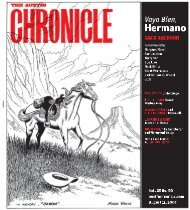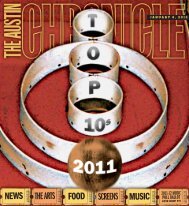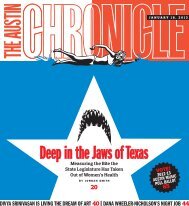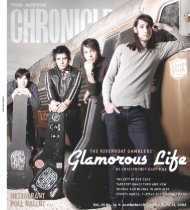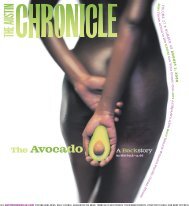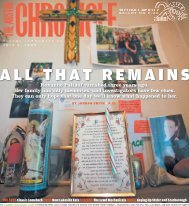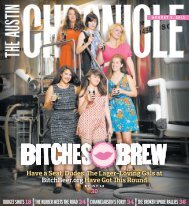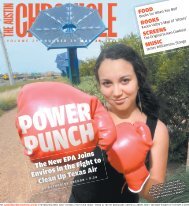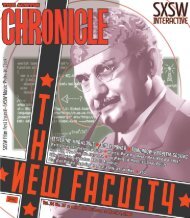R E S T A U R A N T P O L L B A L L O T P . 4 6 - The Austin Chronicle
R E S T A U R A N T P O L L B A L L O T P . 4 6 - The Austin Chronicle
R E S T A U R A N T P O L L B A L L O T P . 4 6 - The Austin Chronicle
- No tags were found...
You also want an ePaper? Increase the reach of your titles
YUMPU automatically turns print PDFs into web optimized ePapers that Google loves.
SCREENSExploitation’sGlass CeilingFeminist filmmaker Stephanie Rothman on her short butbrilliant run making B-moviesBY MARJORIE BAUMGARTENStephanie Rothman directed a spate of exploitation films between 1967 and 1974 and thendisappeared from the industry. Unlike other young directors such as Jonathan Demme, MartinScorsese, Peter Bogdanovich, Jonathan Kaplan, Francis Ford Coppola, and scores more who gottheir starts in producer Roger Corman’s low-budget academy of down-and-dirty filmmaking,Rothman never graduated into the big time. This is not because her films are lacking in qualityor interest. In fact, a case could be made for Rothman being the most productive and consistentlyauteurist filmmaker in the exploitation stable. Her solo films – It’s a Bikini World, <strong>The</strong> StudentNurses, <strong>The</strong> Velvet Vampire, Group Marriage, Terminal Island, and <strong>The</strong> Working Girls – are all solidlymade and infused with feminist ideas and egalitarian impulses toward the depictions of sex,class, race, and government. Why was Rothman unable to film work outside the exploitationsphere, and why has she surfaced to present two films next Wednesday at the Alamo Drafthouseat the Ritz? We had an e-mail conversation with Rothman to explore these very topics.Original lobby cardfrom 1970’s <strong>The</strong>Student Nurses<strong>Austin</strong> <strong>Chronicle</strong>: What was your backgroundin filmmaking, and how did you firstwind up making a movie for AIP [AmericanInternational Pictures]?Stephanie Rothman: I studied filmmakingas a graduate student at the University ofSouthern California’s Dept. of Cinema. Whilethere, I was the first woman to be awarded theDirectors Guild of America Fellowship. Basedon this award, Roger Corman hired me [in1964] to be his assistant and put me to workon low-budget films he was personally financing,or films that he had bought completed butthat still needed work. I did everything: wrotenew scenes, scouted locations, cast actors,directed new sequences, and edited final cuts.Within a year, he financed my first feature film,which I co-wrote with my husband CharlesSwartz and directed. It was called It’s A BikiniWorld, the last of the beach pictures. AIP distributedit, but I was never employed by AIP,nor did I have any contact with the studio.AC: What did you learn from working forRoger Corman?SR: Roger was the only mentor I ever had. Heencouraged me and gave me confidence in mywork, for which I will always be grateful. Hedidn’t teach me any technical skills, I learnedthose at USC, but he generously shared hisextensive experience with me, and gave meuseful criticism and information on how toefficiently organize work on a set so that a filmcould be shot on schedule. Since it was hismoney he was using, I had to shoot fast.AC: Did you consciously seek to subvert the genreconstraints of exploitation filmmaking? Someprominent examples: Your female characters aregenerally independent thinkers who act on theirown choices. Your use of nudity is applied to maleas well as female characters.SR: In the beginning, I didn’t even know thatI was making exploitation films. I first learnedthe term when it was used in a review of <strong>The</strong>Student Nurses. I thought I was making lowbudgetgenre films. But whatever I was makingwas called, it irritated me that many contemporaryfilms, regardless of their budgets, weredishonest about everything from sexual politicsto social conflict. Since I didn’t know howlong I would be able to work making any kindof film, I decided to say what I wanted while Ihad the chance, instead of playing it safe.People have noted, as you did, that thewomen in my films are independent in thoughtand action. I think this stands out because ofthe limited, usually subordinate roles, that werewritten for them in that era. It was indeed myintention to change that in my films. I wantedto create – as in the real world I wanted to see –a more equal and just balance of power betweenthe sexes. That is why in some scenes the menare nude as well as the women, which definitelywas not the convention then. But I wanted thewomen’s independence to extend far beyondthat issue to a life filled with meaning and purposebeyond marriage. Some women lived suchlives in the Seventies, but it was a more novelidea in life and films than it is today.AC: Was there any struggle for you between theexpression of your creative freedom and the constraintsof exploitation filmmaking? Did you feelcompromised? Did it allow you a certain freedomto do what you wanted as long as you hit yourcontractually agreed-upon marks?SR: Working for Roger, and later for DimensionPictures, the company in which my husband"Since I didn’t know how long I would be able to workmaking any kind of film, I decided to say what I wantedwhile I had the chance, instead of playing it safe."– Stephanie Rothmanand I had a small ownership, I didn’t alwaysget to choose the subjects of the film, but Idid have control over the attitude toward andthe treatment of the subjects. In this respect,I didn’t feel compromised or constrained. Ofcourse there were certain audience expectationsthat had to be satisfied, in particularfor nudity and violence. Since I was makingexploitation films with unknown casts,I had to show more nudity than they couldordinarily see in major studio films, but lessthan in the soft porn that was then in release.Furthermore, I had to show up to the limit ofwhat was allowed in an R-rated film (i.e., nopubic hair, no genitals, no simulated intercourse),which looks quite tame by today’sstandards, but wasn’t at the time. Becauseof these scenes I also had to cast very attractivepeople, which meant that sometimes Icouldn’t cast the best actors, which I considereda very serious constraint then, and whichcontinues to disturb me even now.AC: Did you ever seek directing work on filmsthat weren’t exploitation-based, and what werethose results?SR: Yes, I did. I had good agents and togetherwe tried very hard to get me work, but werepeatedly discovered I was stigmatized by thefilms I had made. <strong>The</strong> irony was that I madethem in order to prove that I had the skills tomake more ambitious films, but no one wouldgive me the chance.<strong>The</strong>n there was the other reason, the socalledelephant in the room: I was a woman.No one told me directly, but I often learnedindirectly that this was the decisive reasonwhy many producers wouldn’t agree to meetme. If that sounds exaggerated, remember thatI worked in the American film industry from1965 to 1974, and some of those years I wasthe only woman directing feature films.AC: Why did you quit film directing in 1974?SR: For the next 10 years, I tried to find workmaking more ambitious films. My husbandand I collaborated on a couple of challengingtreatments and scripts that were well received,but never sold. I did sell a few options onscripts and screenplays on my own. I got afew offers to make more exploitation films, butI was never happy making them and I didn’twant to repeat myself. After enduring a decadeof barely making a living, I gave up.AC: What have you been doing since then?SR: For a few years I ran a small proto-unionfor a group of University of California professors,doing their lobbying and writing a politicalnewsletter about labor issues of concern tothem. <strong>The</strong>n, starting with a small inheritance,I began to invest in commercial real estate.AC: If you were starting a career as a newcomerat the beginning of the 21st century, would you stillchoose to go into filmmaking and/or writing?SR: I love this question! Yes, I definitelywould, because the opportunities for gettingone’s work seen are much greater now. <strong>The</strong>reare so many more festivals at which to shownew films. <strong>The</strong>n there are the new digitaltechnologies that give filmmakers at all budgetlevels greater control over their images, andfinally there is the ever-improving and lesscostly equipment that is now available to lowbudgetfilmmakers. But – most revolutionaryof all – there is the Internet, where you can beyour own distributor and seek your own audiencedirectly. Whether you can make a livingthis way is still unproven, but I think thatbusiness models for doing this are evolving. Ialso think established companies in film andtelevision, and major studio and independentdistributors, are again seeking a way to gainsome control over this, to become the gatekeepersthey have always been. So, ultimately,I think the greatest never-ending challenge, forfilmmakers and everyone else, will be how tokeep the Internet a democratic forum. Rothman will attend screenings of <strong>The</strong> Student Nursesat 9:40pm and Group Marriage at midnight on Wednesday,April 14 at the Alamo Drafthouse at the Ritz.50 T H E A U S T I N C H R O N I C L E APRIL 9, 2010 a u s t i n c h r o n i c l e . c o m



